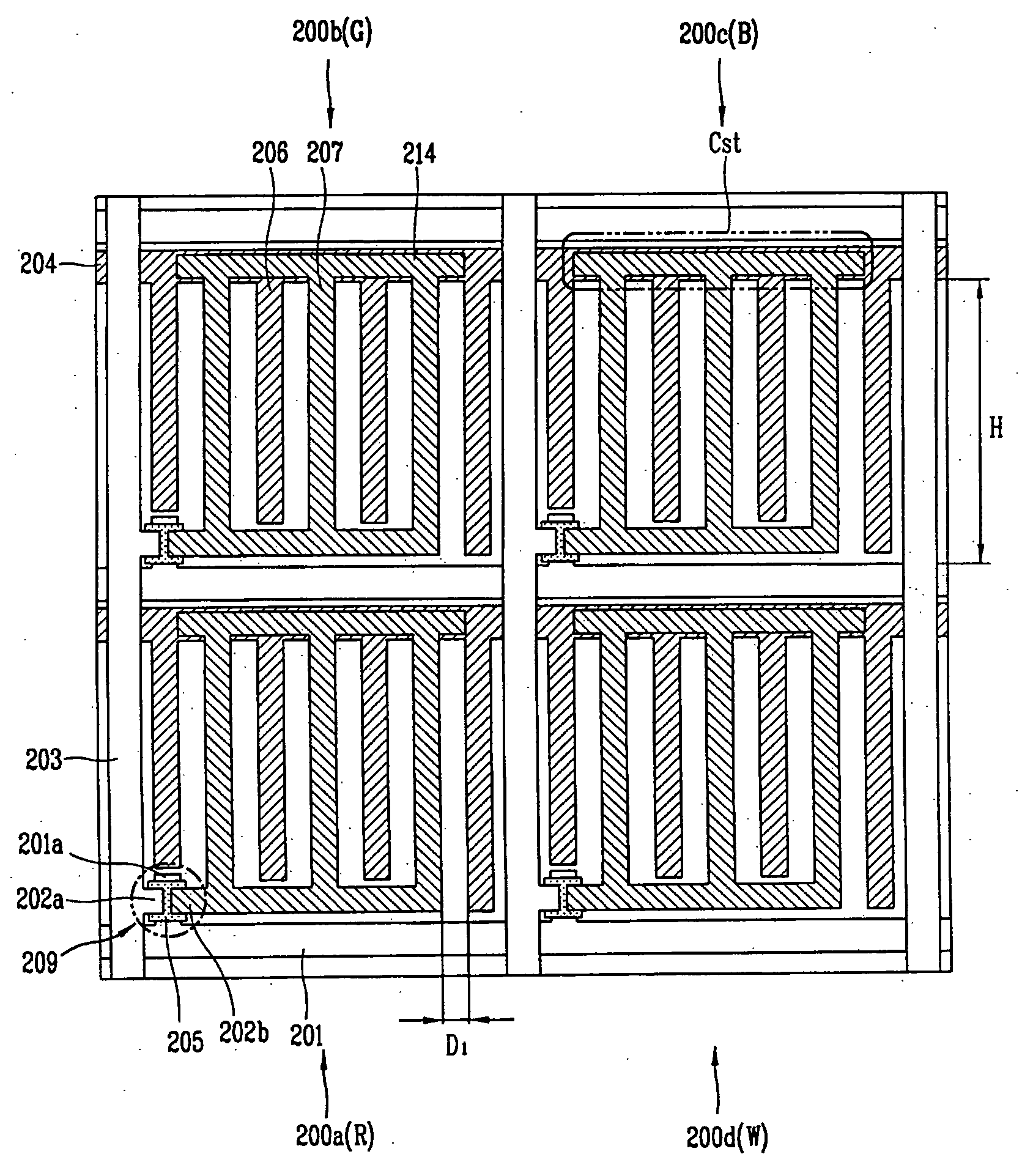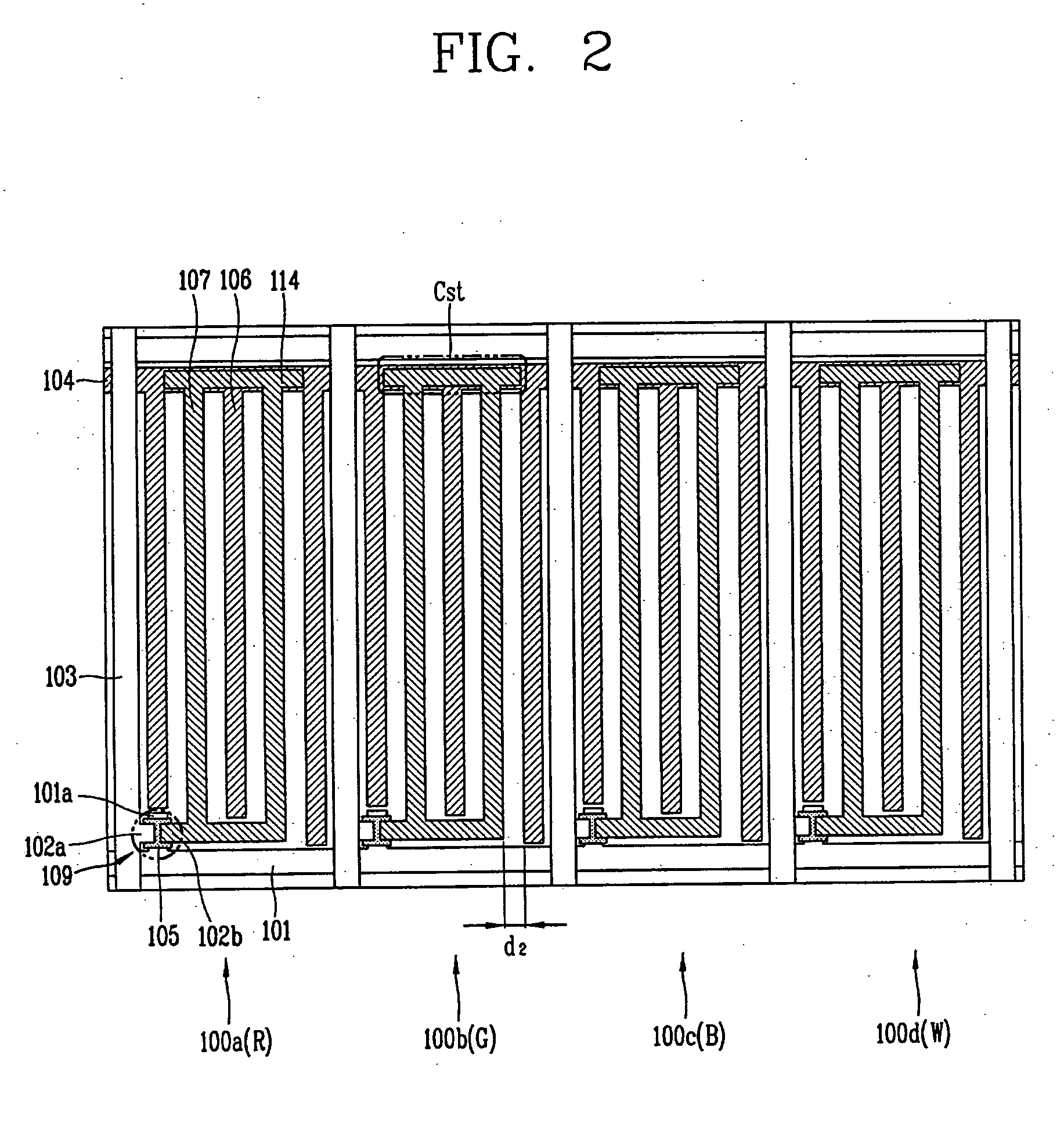In plane switching mode liquid crystal display device and fabrication method thereof
- Summary
- Abstract
- Description
- Claims
- Application Information
AI Technical Summary
Benefits of technology
Problems solved by technology
Method used
Image
Examples
first embodiment
[0033]FIG. 2 illustrates the present invention: an in plane switching (IPS) mode liquid crystal display (LCD) device having a four transmissive regions within each sub-pixel. This embodiment of the IPS mode LCD device has a white(W) sub-pixel 100d in addition to the Red(R), Green(G) and Blue(B) sub-pixels (100a-100c). Here, the W sub-pixel 100d may be accommodated by reducing the width of each sub-pixel and maintaining the transmissive area of each sub-pixel.
[0034] The sub-pixels 100a, 100b, 100c and 100d are defined by a gate line 101 and a data line 103 arranged horizontally and vertically. In each sub-pixel 100a, 100b, 100c, 100d, a pixel electrode 107 substantially perpendicularly connects to a pixel electrode line 114, and a common electrode 106 perpendicularly connects to a common line 104. The pixel electrode 107 and the common electrode 106, which are alternately disposed, generate an in-plane electric field in the pixel when a voltage is applied between them. In addition, t...
second embodiment
[0038] As illustrated in FIG. 3, the IPS mode LCD device has R, G, B and W sub-pixels 200a-200d, each having six transmissive regions, wherein the sub-pixels are arranged in the 2×2 matrix to form a unit pixel (P). The sub-pixels 200a-200d are defined by gate lines 201 and data lines 203, respectively, and are arranged horizontally and vertically. In each sub-pixel 200a-200d is at least one pair of electrodes, a pair including a pixel electrode 207 connected to the pixel electrode line 214, and a common electrode 206 connected to the common line 204. The pixel electrodes 207 may be substantially perpendicularly oriented relative to the pixel electrode line 214, and the common electrode 206 may be substantially perpendicularly oriented relative to the common line 204. The pixel electrodes 207 and the common electrodes 206 may be alternately disposed and generate an in-plane electric field in the pixel on the application of a voltage. Further, the pixel electrode line 214 may overlap...
third embodiment
[0043] As illustrated in FIG. 4, in the IPS mode LCD device a unit pixel is divided into sub-pixels by a common line 304 passing substantially through a center of the pixel (P) parallel to a gate line 301, and R, G, B and W sub-pixels 300a-300d are arranged in a 2×2 matrix form. The region above the common line 304 may be referred to as a first region, and the region below the common line 304 may be referred to as a second region. As illustrated in FIG. 4, the G and B sub-pixels 300b and 300c are disposed in the first region, and R and W sub-pixels 300a and 300d are disposed in the second region. It will be apparent that this exemplary embodiment may have the R, G, B, and W sub-pixels arranged in other configurations than that shown in FIG. 4.
[0044] The common line 304 is electrically connected to at least one common electrode 306 disposed in each sub-pixel, and forms a storage capacitor (Cst) together with a pixel electrode line 314 overlapping the common line 304. As illustrated ...
PUM
 Login to View More
Login to View More Abstract
Description
Claims
Application Information
 Login to View More
Login to View More - R&D
- Intellectual Property
- Life Sciences
- Materials
- Tech Scout
- Unparalleled Data Quality
- Higher Quality Content
- 60% Fewer Hallucinations
Browse by: Latest US Patents, China's latest patents, Technical Efficacy Thesaurus, Application Domain, Technology Topic, Popular Technical Reports.
© 2025 PatSnap. All rights reserved.Legal|Privacy policy|Modern Slavery Act Transparency Statement|Sitemap|About US| Contact US: help@patsnap.com



